|
Major battles during WWI in France where Sikhs were present:
Ypres
La Bassée
Neuve Chapelle
Festubert
Loos
Givenchy
Somme
Regiments present in France 1914-15 comprising Sikh companies:
INFANTRY
9th Bhopal Infantry
15th Ludhiana Sikhs
47th Sikhs
57th Frontier Force
58th Frontier Force
59th Frontier Force
89th Punjabis
107th Pioneers
CAVALRY
2nd Lancers
3rd Skinner's Horse
4th Cavalry
6th King Edward's Own Cavalry
9th Hodson's Horse
18th King George's Own Lancers
19th Lancers
20th Deccan Horse
29th Lancers
30th Lancers
36th Jacob's Horse
38th King George's Own Central India Horse
39th King George's Own Central India Horse
The 15th, the oldest Sikh battalion, and the 47th, the latest raised, were the first to be given the opportunity of showing the mettle of the Khalsa in a European war. The 47th, who were not raised till 1901, earned as proud a record as any in France, distinguishing themselves from the day in October, 1914, when, with the 20th and 21st Sappers and Miners. They cleared the village of Neuve Chapelle after some Homeric hand-to-hand fighting in the houses and streets, to the desperately stubborn advance up the glacis to the German trenches on April 26, 1915, in the second battle of Ypres, when the regiment went in with eleven British and ten Indian officers and 423 other ranks, of whom but two British and two Indian officers and 92 rank and file mustered after the action. The 15th Sikhs, one of the two earliest-raised Sikh battalions, were the first, to come into action in France, and they maintained a high-level reputation for gallantry all through the campaign.
The story of Lieutenant Smyth and his ten Sikh bombers at Festubert is not likely to be forgotten. Smyth and two sepoys were the only two survivors of this gallant band who passed by a miracle, crawling over the dead bodies of their comrades, through a torrent of lead, and carried their bombs through to the first line. Smyth was awarded the V.C., Lance-Naik Mangal Singh the Indian Order of Merit, and every sepoy in the party the Indian Distinguished Service Medal. Two of these men belonged to the 45th Sikhs, four to the 19th Punjabis. And here it should be remembered that the Sikhs earned a composite part of the honour of nearly every mixed class-company regiment in France; of the Punjabi regiments, for instance, and of the Frontier Force Rifle battalions, in which the number of Sikh companies varies from one to four, not to mention the Sappers and Miners.
It was in the very first days of the Indians' debut in France that a Sikh company of the 57th Rifles earned fame when it was believed that the line must have given way, holding on all through the night against repeated counter attacks, though the Germans were past them on both flanks. As for the Sappers, the story of Dalip Singh is pure Dumas. This fire-eater helped his fallen officer, Lieut. Rail-Kerr, to cover, stood over him and kept off several parties of Germans by his fire. On one occasion — a feat almost incredible, but well established — he was attacked by twenty of the enemy, but beat them all off and got his officer away.1
Extract taken from The Sepoy, Edmund Candler (London, John Murray, 1919).
1"The Indian Corps in France" by Lieut.-Colonel J. W. B. Merewether, C.I.E., and Sir Frederick Smith.
Neuve Chapelle - India's Memorial in France
On October 7th, 1927, the Earl of Birkenhead, Secretary of State for India, unveiled the noble Memorial which has been erected by the Imperial War Graves Commission at Neuve Chapelle in France, to the memory of the Indian soldiers who fell on the Western Front in the Great War of 1914-1918…. It is a tribute of special significance in that to build it the Dominions combined with India and the Mother Country, just as in the building of memorials to English, Scots, and Irish, Canadians, Australians, New Zealanders, South Africans, and Newfoundlanders, India took her part and paid her share of the cost. In a special sense, too, it marks the gratitude of the great French nation to defend whose soil from German invasion the supreme sacrifice of the Indian Army in France was primarily made. It marks French gratitude because the place where it is built is French soil and because France has received it into her keeping for evermore. For this occasion, unique in the long history of India, a contingent of Indian troops representative of the various units engaged — Sikhs, Dogras, Garhwalis — was specially brought from India in order that they might share in the ceremony and might take back to India a more vivid picture than any photographs can hope to give.
Extract taken from Neuve Chappelle - India's Memorial in France 1914-1918, (London, Hodder & Stoughton, 1927).
The back semi-circular wall is solid and in the centre of it is a tablet bearing the following inscriptions:-
TO THE HONOUR OF THE ARMY OF INDIA WHICH
FOUGHT IN FRANCE AND BELGIUM 1914-1918, AND
IN PERPETUAL REMEMBRANCE OF THOSE OF THEIR
DEAD WHOSE NAMES ARE HERE RECORDED AND
WHO HAVE NO KNOWN GRAVE.
EN HONNEUR DE L'ARMEE DE L'NDE QUI A COM-
BATTU EN FRANCE ET EN BELGIQUE 1914-1918, ET
POUR PERPETUER LE SOUVENIR DE SES MORTS AUX
TOMBES INCONNUES DONT LES NOMS SONT ICI
GRAVES.
On the walls on either side the names of the Missing are inscribed in a great semi-circle.
Extract taken from Neuve Chappelle - India's Memorial in France 1914-1918, (London, Hodder & Stoughton, 1927).
Speaking in French, Marshal Foch told of India's effort in the Allied cause, how she had raised more than a million soldiers, how she had lost upwards of one hundred thousand men. After telling the story of the battles from the 10th to 13th March, 1915, the Marshal described how the Indian Corps opened the attack.
"The Indian Troops," he said, "were thus among the first to show the way to a victorious offensive. It is only right that a Memorial should perpetuate the glorious memory of officers, non-commissioned officers, and men of the Indian Army at the very spot where later on a general attack by the Allied troops was to bring the decisive victory in sight."
Turning to the Indian Contingent, he bade them: "Return to your homes in the distant, sun-bathed East and proclaim how your countrymen drenched with their blood the cold northern land of France and Flanders, how they delivered it by their ardent spirit from the firm grip of a determined enemy; tell all India that we shall watch over their graves with the devotion due to all our dead. We shall cherish above all the memory of their example. They showed us the way, they made the first steps towards the final victory."
Extract taken from Neuve Chappelle - India's Memorial in France 1914-1918, (London, Hodder & Stoughton, 1927).
| Image |
The Great War in France |
Accompanying Quote |
 |
A remarkable French postcard heralding the arrival of Sikh troops of the 15th Sikh regiment. The leading soldier is seen holding the French tricolor. The Sikh regiment first landed in Marseilles on 26 September 1914 and received a heroes' welcome. "Unique stalwarts from the east" remarked the press. Not only were they welcomed, but throughout the war the French with whom they came into contact, treated them with unwonted friendliness and a spirit of equality. The caption to the postcard reads in French "Les troupes indiennes viennent chattier les brigands allemands" and in English "Gentlemen of India marching to chasten German hooligans". |
|
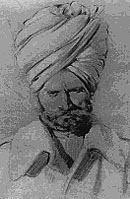 |
Drawings by Paul Sarrut from the French postcard series "Types de l'Armee de l'Inde" (Men of the Indian Army). The postcard was effectively employed as a medium for raising awareness of the Sikhs amongst the French public. The caption accompanying this picture reads: "Sepoy Harnam Singh, type de Sikh. Mot Singh dont les Sikhs font suivre leur nom veut dire: Lion". (Sepoy Harnam Singh, a Sikh. The word Singh which the Sikhs have as a surname means Lion.) |
"The English and the women of this place [France] are very pleased to see us, like opening flowers. They shake hands with our men when they disembark, and attempt to feed them from their own pocket...The Germans are very frightened of our men, but they are sturdy fellows. Several times they have displayed the white flag and then attacked, but now we know their tricks and have taken many of them prisoner. Spread this news everywhere because this is the only letter that I can send you."
From a letter, dated 15th December 1915, written by a Sikh cavalry soldier at a Marseilles Depot.
Further Extracts from Reports made by the Censor, Indian Mails in France, British Library. |
 |
A Company of the 15th Sikhs, headed by Lieutenant John Smythe VC, turning into their billets in a Flanders village after being relieved from the front line, 1915. Flanders is a strategically located area on the continental side of the English Channel running from what is now the north of France through Belgium and into the Netherlands. It was a perpetual battleground in World War I and a critical area during World War II. |
"56 years ago I joined the 15th Ludhiana Sikhs in Loralai, Baluchistan and at once became embued with the teachings and the life of Guru Nanak. The Sikh Gurus, the Sikh religion, the Gurdwara, the Granth Sahib became part of my life. The British and Sikh officers of the Regiment were convinced that religion was an important factor in the make-up of a good soldier and we fostered that in every way possible."
An extract from a speech made by Brigadier the Rt. Hon. Sir John Smythe, Bt.VC at a celebration of the 500th Birthday Anniversary of Guru Nanak at Grosvenor House in Park Lane in December, 1969. |
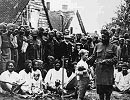 |
Flanders, 1915. A boy poses with a Sikh soldier billeted at his village after an exchange of gifts. In the crowd behind, men of the village and other Sikhs look on. |
"If God spares me to return, I intend to start new customs. Look, in our country people ruin themselves over marriages and lawsuits. In this country rich and poor, high and low, go to church together and worship, and there is no distinction between them there... The very best custom in this country is that a man chooses his own wife, and a women her husband."
From a letter written by a Sikh cavalryman just before leaving France in 1918.
Supplementary letters forwarded by the Censor, Indian Mails in France, British Library. |
 |
Marching down the Champs Elysees, Sikh troops receive a flower from a Parisian well-wisher during the Great Parade in Paris at the close of the First World War. |
"The scene is one that should be retained on the Empires retina. The hosts of Indian soldiers marched through the streets of Marseilles with the population, especially the female proportion, hanging onto the arms of bewildered Sikhs and Pathans."
The Martial races of India, Lt Gen Sir George MacMunn, 1923 |
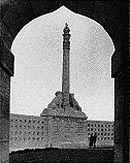 |
Neuve Chapelle - India's memorial in France 1914-1918. The column and the battle honours. |
|
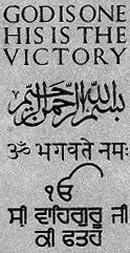 |
Neuve Chapelle - India's memorial in France 1914-1918. The writing on the column (written in English, Arabic, Hindi and Gurmukhi). |
|
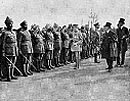 |
Neuve Chapelle - India's memorial in France 1914-1918. Marshal Foch inspecting the Indian contingent. |
|
|







